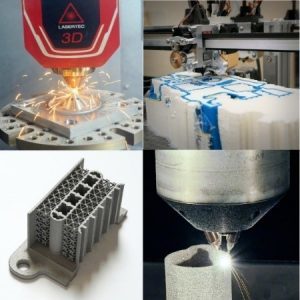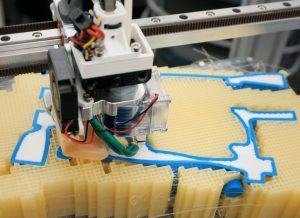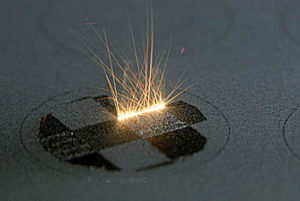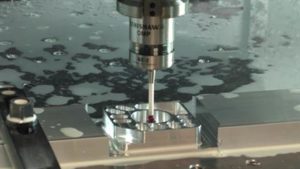By Gregg Profozich, Director, Advanced Manufacturing Technologies, California Manufacturing Technology Consulting (CMTC)
Looking for an additive manufacturing guide that can tell you if this technology is right for your Rhode Island manufacturing business? In this series of posts we’ll share a depth of information regarding additive manufacturing, its benefits, what to consider when getting started, and more.
 Additive Manufacturing, also known as 3D printing, has gone from a futuristic novelty to a widely available technology. Even though additive manufacturing has been around since the mid-1980s, the growth in use and commercialization of the technology has exploded in the last five years. Printers have gotten faster, cheaper, and more compact, not to mention the ever-growing selection of plastic and metal materials.
Additive Manufacturing, also known as 3D printing, has gone from a futuristic novelty to a widely available technology. Even though additive manufacturing has been around since the mid-1980s, the growth in use and commercialization of the technology has exploded in the last five years. Printers have gotten faster, cheaper, and more compact, not to mention the ever-growing selection of plastic and metal materials.
Additive manufacturing breaks the limits of traditional methods by changing the way the production parts are created and supported. When applied to the right situations, additive manufacturing can deliver products with greater efficiency and improved performance. The advantages don’t stop there, though; there are a wealth of financial advantages to 3D printing, ranging from reduced product waste to lower cost for complex parts to revenue opportunities on small quantity production.
What is Additive Manufacturing?
Additive manufacturing, or 3D printing, is a process that creates a tangible object from a digital design. While a traditional 2D printer uses a computer to read a file and print out a flat, two-dimensional replica on fabric or paper, 3D printing creates a physical object from a digital file, utilizing layer after layer of material, until it forms a completed three-dimensional object.
Additive manufacturing technologies build three-dimensional objects one fine layer at a time. Each subsequent layer bonds to the preceding later of partially melted material. In other words, instead of removing material during the production process to make part features such as holes, the part would be constructed using additive manufacturing methods with the hole already formed in the finished part.
The material can be almost any type of substance, ranging from metal powder, ceramics, thermoplastics, glass – even chocolate! As a result, 3D printers are not one-size-fit-all; there are a variety of options for 3D printing, thus the type of printer ranges for different applications.
Additive manufacturing has been used to build physical models, prototypes, tooling components, and production parts in a variety of media, including metal plastic, and composite materials. Almost any shape can be replicated on a 3D printer, and parts can be manufactured in a variety of colors and even with more than one material.
5 Benefits of Leveraging Additive Manufacturing in Your Manufacturing Facility
 3D printing has been heralded for its innovative industrial manufacturing abilities. There are several advantages that make this manufacturing technology a valuable asset championed by companies around the world, including several in Rhode Island.
3D printing has been heralded for its innovative industrial manufacturing abilities. There are several advantages that make this manufacturing technology a valuable asset championed by companies around the world, including several in Rhode Island.
1. Reduced Development Costs
This advanced manufacturing technology has the stereotype of being somewhat pricey, due to its initial cost. However, the long-term reduced development costs yield money-saving benefits.
In terms of machine operation costs, it depends on the size of the 3D printer. Most desktop 3D printers use as much power as a laptop, while some large industrial 3D printers use a significantly larger amount. Still, their ability to produce complex objects in a single step results in greater efficiency and productivity.
One of the main advantages of 3D printing is the reduced cost of labor. Besides post-processing, most printers are self-sufficient and barely need assistance from an operator. The labor costs for a 3D printer are essentially nonexistent, compared to traditional manufacturing where highly skilled operators are usually necessities.
Additionally, additive manufacturing at low volumes is competitive in cost compared to traditional manufacturing. It is significantly less expensive to 3D print prototypes rather than with other manufacturing methods, such as injection molding, traditional dies, molds, milling, and machining.
2. Less Product Waste
By designing drafts in a computer program and then sending them to be printed, the time to create and produce new designs is drastically shortened with less waste. This digital-to-digital process removes the additional intermediate steps of traditional prototyping.
Additionally, 3D printing has increased turnaround. With the ability to create quick iterations, 3D printing identifies engineering and design issues that may have taken weeks, if not months, to discover in traditional manufacturing.
Additive manufacturing enables the creation of complex designs that are normally too difficult or too expensive to build. Process development can be accomplished in less time with less money spent on designing and building prototypes with traditional methods, such as molds and dies. There is also less product waste from the need to scrap molds for parts and features that have changed in prototype iterations.
Decisions on final part designs can be achieved faster because the time required for effective design and creation is reduced. Overall, additive manufacturing offers a more effective and efficient design process with less waste and reduced spending.
3. Improved Quality of Products
 The advantages of 3D printing extend into providing better quality product design and process development. Additive manufacturing allows manufacturers to create superior products because design issues, such as bad ergonomics, can be identified early and resolved swiftly. As a result, the quality of the parts can be improved with a better final design with 3D printing.
The advantages of 3D printing extend into providing better quality product design and process development. Additive manufacturing allows manufacturers to create superior products because design issues, such as bad ergonomics, can be identified early and resolved swiftly. As a result, the quality of the parts can be improved with a better final design with 3D printing.
Furthermore, this technological advancement allows engineers to build complex and intricate parts that are not cost-effective or even possible with typical manufacturing methods. Engineers are no longer restricted to the limitations of traditional equipment; some parts that were designed as assemblies requiring joining, fastening, or welding can be printed as a single part. This reduces waste while often adding greater strength and durability to the product and reduces the potential points of failure.
3D printing can also create parts out of a variety of different substances, such as thermoplastics. Some of these materials can substantially reduce weight while still maintaining strength and integrity. This is exceptionally helpful when engineers want to maintain strength but reduce weight.
Additive manufacturing can be a valuable technology to create durable products that can maintain continuous use due to their improved quality.
4. Genuinely Rapid Prototyping
Do you remember when “rapid” prototyping meant a lead-time of weeks or months to design and manufacture? This was primarily due to the need to manufacture a prototype tool or fixture and probably outsource a portion of this work, as many manufacturers focused on production, but didn’t want to tie up valuable time to produce a singular prototype part.
With additive manufacturing, you can design and produce a prototype on a 3D printer in hours – not weeks! Instead of designing for manufacturing, you can now manufacture for design. In addition, parts can be produced to specifically meet complex customer specifications. This is a game-changer for prototyping.
What does this mean for your company? With a relatively small investment in a 3D printer and expertise, you can now quickly produce mock-ups of a new product and have it in the customer’s hands in a matter of days. Plus, you can produce a part to meet a very specific market niche, which could lead to the production of high-profit margin products.
5. A Means to Attract Talent, Expertise, and Enthusiasm to Your Company
 Incorporating additive manufacturing and other new technologies into your workplace will help you attract skilled workers from the younger generation, including Millennials.
Incorporating additive manufacturing and other new technologies into your workplace will help you attract skilled workers from the younger generation, including Millennials.
Stay tuned for Part 2 of our additive manufacturing guide! In our next post we’ll address:
- Is Additive Manufacturing Right for Your Company? 5 Considerations to Make Before Implementing This Manufacturing Technology
- Maximize Your Investment in Additive Manufacturing With the MEP National Network
About the Author
Like Polaris MEP, California Manufacturing Technology Consulting (CMTC) is part of the Hollings Manufacturing Extension Partnership (MEP) Program.
Gregg Profozich serves as Director, Advanced Manufacturing Technologies for the CMTC. He is a manufacturing, operations and technology executive who believes that manufacturing is the key creator of wealth in the economy and that a strong manufacturing sector is critical to our nation’s prosperity and security now, and for future generations. Across his 20-year plus career in manufacturing, operations and technology consulting, Mr. Profozich helped manufacturing companies from the Fortune 500 to the small, independents significantly improve their productivity and competitiveness.
